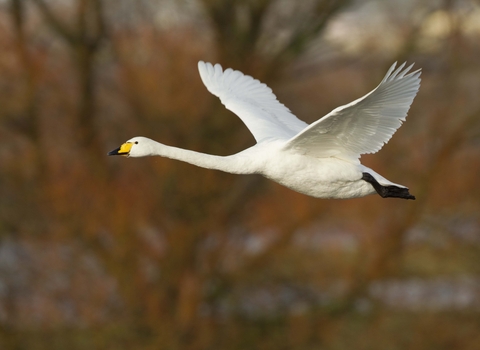
©Danny Green/2020VISION

©Danny Green/2020VISION
Whooper swan
The whooper swan is a very rare breeding bird in the UK, but has much larger populations that spend winter here after a long journey from Iceland. It has more yellow on its yellow-and-black bill than the Bewick's Swan.
Scientific name
Cygnus cygnusWhen to see
October to MarchSpecies information
Category
Statistics
Length: 1.5mWingspan: 2.3m
Weight: 9.3kg
Average lifespan: 9 years
Classified in the UK as Amber under the Birds of Conservation Concern 5: the Red List for Birds (2021). Protected in the UK under the Wildlife and Countryside Act, 1981.
Habitats
About
Whooper swans spend their winters in this country; they arrive from Iceland in late autumn, returning north again in the spring. They will often feed on fields during the day, eating crops like leftover potatoes and grain, before heading to roost on open water.How to identify
Larger than the Bewick's swan, the whooper swan has more yellow and on its bill. It has white plumage and the characteristic long neck of a swan.Distribution
A few pairs nest in Scotland, but most nest in Iceland and winter in the north of the UK and East Anglia.In our area
Whooper swans could be spotted on large water bodies in Shropshire as they stop off on route further south for the winter. They have been spotted on The Mere at Ellesmere and on Chelmarsh near Bridgnorth in previous years.
Did you know?
In the spring, whooper swans will fly, non-stop, from Scotland to Iceland. During this migration, they may travel at very high altitudes; a pilot flying at 8,000 metres once reported seeing a flock of swans that were thought to be whoopers.Whooper swans could be spotted on large water bodies in Shropshire as they stop off on route further south for the winter. They have been spotted on The Mere at Ellesmere and on Chelmarsh near Bridgnorth in previous years.

